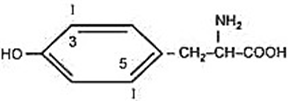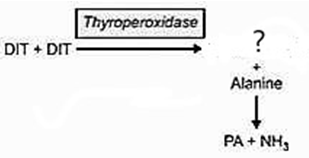This set of Molecular Endocrinology Multiple Choice Questions & Answers (MCQs) focuses on “Thyroid Gland and its Hormones – Set 2”.
1. Which among the following is the correct structure of the precursor mono iodotyrosine (MIT)?
a)

b)

c)

d)

View Answer
Explanation: Iodination of tyrosine residue in thyroglobulin happens first in the “3 position” of the mono-iodotyrosine aromatic nucleus. In “position 5,” mono iodotyrosine is then iodinated to form “di iodotyrosine.”
2. In the coupling reaction given below which is the hormone that is produced during the oxidative condensation of di iodotyrosine precursor?

a) Parathormone
b) Thyroxine (T4)
c) Tri-iodothyronine (T3)
d) ‘Reverse’ (T3)
View Answer
Explanation: When undergoing oxidative condensation, two DIT molecules, under the control of the enzyme thyroperoxidase, form Thyroxine (T4) molecules that are peptide-linked. A trace of “alanine” is released in the process, which gradually forms pyruvate and ammonia.
3. Which hormone is formed in the condensation reaction of mono iodotyrosine (MIT) and di iodotyrosine (DIT) given below?

a) Thyroxine (T4)
b) Parathormone
c) Tri-iodothyronine (T3)
d) ‘Reverse’ (T3)
View Answer
Explanation: Tri-iodothyronine (T3) is likely to be formed by MIT condensation with a DIT molecule. An alanine residue is released as a byproduct here just like the formation of thyroxine (T4). Triiodothyronine is a thyroid hormone, also known as T3. Almost every physiological process in the body, including development and growth, metabolism, temperature of the body and heart rate, is affected by this hormone.
4. The iodine trapping is done against electrical gradient and concentration gradient.
a) True
b) False
View Answer
Explanation: The thyroid acinar cell has a resting membrane potential of-50 mV and is around 50 mV detrimental to the interstitial region and the colloid. Thus, iodide is probably pumped against the electrical gradient in the acinar cell at its base. The thyroid to plasma/serum free iodide ratio (T/S ratio) varies from 10:1 to more than 100:1. Iodine is therefore taken up against the ‘concentration gradient.’
5. During the fusion of the vesicle with the apical plasma membrane, thyroperoxidase is ‘activated’ by hydrogen peroxide in the oxidation process of iodine.
a) True
b) False
View Answer
Explanation: During the fusion of the vesicle with the apical plasma membrane, thyroperoxidase is activated by hydrogen peroxide in iodine oxidation process. It is actually synthesized in its inactive form in the endoplasmic reticulum.
6. Which hormone in the thyroid cells helps in the deiodination of iodotyrosine?
a) Thyroxine
b) Dehalogenase
c) Dehydrogenase
d) Lysozyme
View Answer
Explanation: Thyroid cells have a de-iodinase (dehalogenase) microsomal enzyme that uses NADPH, and iodotyrosines are easily de-iodinated as a result. The extracted iodides in the gland are recycled and used to synthesise thyroid hormones.
7. Which protein acts as the carrier agents for the thyroid hormones?
a) Thyroxine-binding proteins
b) Thyroxine-carrier proteins
c) Thyroid proteins
d) Thyroid oxidation proteins
View Answer
Explanation: T4 and T3 are mainly transported almost in conjunction with two proteins within the plasma. They are referred to as “thyroxine-binding proteins” that serve as the hormone’s particular carrier agents.
8. Which among the following is an example of thyroxine-binding proteins?
a) Thyroxine-binding casein
b) Thyroxine-binding fibrin
c) Thyroxine-binding albumin
d) Thyroxine-binding globulin (TBG)
View Answer
Explanation: Thyroxine-binding globulin (TBG) and thyroxine-binding prealbumin (TBPA) are two primary carrier proteins (TBPA). The hormones can be bound to “serum albumin” when significant quantities of T4 and T3 are present and the binding capacities of the above two basic carrier proteins are saturated.
9. Which among the following is a condition that leads to high TBG (Thyroxine-binding globulin) levels?
a) Pregnancy
b) Menstruation
c) Nephrosis
d) Hyperthyroidism
View Answer
Explanation: TBG levels can become irregular in some situations and may affect the binding of hormones. A rise occurs in many cases including pregnancy following estrogen administration and in women taking contraceptive pills.
10. Which condition leads to elevated T3 concentration which results in a thyrotoxic state?
a) Chemical hypothyroidism
b) Chemical hyperthyroidism
c) Anemia
d) Goiter
View Answer
Explanation: The T3 concentration is elevated and accounts for the thyrotoxic state in rare individuals with chemical hyperthyroidism, where the circulating level of bound and free T4 is normal. In these patients, de-iodination of T4 at the peripheral level produces a significant amount of T3.
Sanfoundry Global Education & Learning Series – Molecular Endocrinology.
To practice all areas of Molecular Endocrinology, here is complete set of 1000+ Multiple Choice Questions and Answers.
If you find a mistake in question / option / answer, kindly take a screenshot and email to [email protected]
